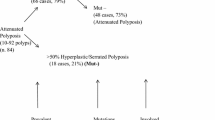Abstract
PURPOSE: The aim of this study is to show that the diagnosis of attenuated adenomatous polyposis coli must be made with caution and certainly only after adequate colonic examination with dye-spray. METHODS: Four patients thought to have attenuated adenomatous polyposis coli on the basis of family history and the identification of fewer than 100 polyps on simple colonoscopy underwent colonoscopy with dye-spray. RESULTS: All four individuals were found to have more than 100 polyps when dye-spray was used, confirming a diagnosis of classical familial adenomatous polyposis. CONCLUSIONS: The diagnosis of familial adenomatous polyposis may be missed altogether or incorrectly assigned as attenuated adenomatous polyposis coli if dye-spray is not used at colonoscopy. Patients with a family history of familial adenomatous polyposis or colorectal cancer should be considered for dye-spray before the diagnosis of familial adenomatous polyposis is excluded or one of attenuated adenomatous polyposis coli is made.
Similar content being viewed by others
References
Bussey HJ. Familial Polyposis Coli. Family Studies. Histopathology, Differential Diagnosis, and Results of Treatment. Baltimore: The Johns Hopkins University Press, 1975.
Spirio L, Olschwang S, Groden J,et al. Alleles of theAPC gene: an attenuated form of familial polyposis. Cell 1993;75:951–7.
Scott RJ, van der Luijt R, Spycher M,et al. Novel germlineAPC gene mutation in a large familial adenomatous polyposis kindred displaying variable phenotypes. Gut 1995;36:731–6.
Eccles DM, van der Luijt R, Breukel C,et al. Hereditary desmoid disease due to a frameshift mutation at codon 1924 of theAPC gene. Am J Hum Genet 1996;59:1193–201.
van der Luijt RB, Meera Khan P, Vasen HF,et al. Germline mutations in the 3′ part ofAPC exon 15 do not result in truncated proteins and are associated with attenuated adenomatous polyposis coli. Hum Genet 1996;98:727–34.
Scott RJ, Froggatt NJ, Trembath RC,et al. Familial infiltrative fibromatosis (desmoid tumours) (MIM135290) caused by a recurrent 3′APC gene mutation. Hum Mol Genet 1996;5:1921–4.
Laken SJ, Petersen GM, Gruber SB,et al. Familial colorectal cancer in Ashkenazim due to a hypermutable tract in APC. Nat Genet 1997;17:79–83.
Frayling IM, Beck NE, Ilyas M,et al. TheAPC variants I1307K and E1317Q are associated with colorectal tumors, but not always with a family history. Proc Natl Acad Sci U S A 1998;95:10722–7.
Pedemonte S, Sciallero S, Gismondi V,et al. Novel germlineAPC variants in patients with multiple adenomas. Genes Chromosom Cancer 1998;22:257–67.
Lynch HT, Smyrk T, McGinn T,et al. Attenuated familial adenomatous polyposis (AFAP). A phenotypically and genotypically distinctive variant of FAP. Cancer 1995;76:2427–33.
Phillips RK, Spigelman AD. Can we safely delay or avoid prophylactic colectomy in familial adenomatous polyposis? Br J Surg 1996;83:769–70.
Author information
Authors and Affiliations
Additional information
Marina Wallace, Susan Clark, and Ian Frayling were supported by the Imperial Cancer Research Fund.
About this article
Cite this article
Wallace, M.H., Frayling, I.M., Clark, S.K. et al. Attenuated adenomatous polyposis coli. Dis Colon Rectum 42, 1078–1080 (1999). https://doi.org/10.1007/BF02236707
Issue Date:
DOI: https://doi.org/10.1007/BF02236707




